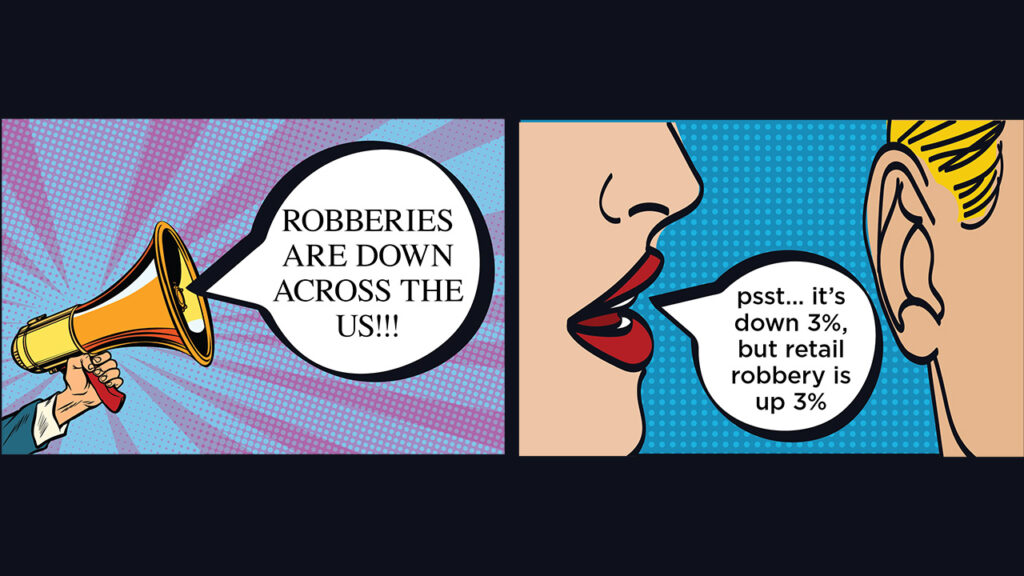 This interview with Dr. Grant Drawve, CAP Index’s VP of Research and Innovation and Walter Palmer, CAP Index’s COO/EVP was featured in Loss Prevention Magazine’s Winter Edition 2024 “Ask the Expert” feature. The LPM version can be found by clicking here.
This interview with Dr. Grant Drawve, CAP Index’s VP of Research and Innovation and Walter Palmer, CAP Index’s COO/EVP was featured in Loss Prevention Magazine’s Winter Edition 2024 “Ask the Expert” feature. The LPM version can be found by clicking here.
This discussion is the first in a series about their perspective on how to: use crime data, evaluate trends, view headlines and statistics in the mainstream media with healthy skepticism, and, most importantly, use data and modeling to improve operations, lower risks, and properly allocate resources.
LPM: Over the past few years, there have been SO many articles about crime. First, it was about the dramatic rise in some crime types, like murder, during the COVID years. Now, with the latest FBI data release, we keep seeing reports about violence decreasing across the nation. These stats are not resonating with our readers when they look at what is happening at their locations. What are your thoughts on this?
DRAWVE: Of course, we love seeing headlines about violence decreasing across the nation. The catchy headlines about national numbers provide just that, an overview, but fail to speak to what is going on more granularly within the United States. We should not only expect city-level variation, but also neighborhoods experiencing varied levels of violence. In short, nationwide and city-level numbers could indicate violence has decreased but when examining smaller units of analysis such as neighborhoods, violence could be increasing. This is incredibly important to understand as it relates to security/guardianship/risk.
LPM: We also see lots of reports about the “most dangerous cities in America” or, conversely, “the safest cities in the US.” What are your thoughts on these types of reports?
City-level reports do not provide as much actionable information since neighborhoods within a city could be high or low in crime occurrence.DRAWVE: Lists about the most dangerous or safest cities often overgeneralize crime occurrence. Many of these lists rely on national numbers that come with their own data limitations, making it inappropriate to categorize cities in such a manner. These lists usually do not delve into the crime nuances such as the contextual factors that relate to crime occurrence. Many of these lists do not give enough importance to population or population density when making comparisons. For instance, with smaller cities a small change in the number of crimes could reflect a larger crime rate increase from year to year. This could be misleading when compared to a larger city. Again, city-level reports do not provide as much actionable information since neighborhoods within a city could be high or low in crime occurrence.
PALMER: I think everyone ‘in the industry’ understands this point from both personal experience and operating locations across different geographies. But, when your CEO reads an article in the Wall Street Journal that crime is increasing/decreasing across the US, they might not understand what appears to us as an obvious over-simplification in thinking about crime. It is the job of the practitioner to help them, and the organization, take an unbiased and data-driven approach to acting on these types of reports.
LPM: Many of the articles talk about ‘crime’ as one monolith of activity – crime is up, or it is down. Is this accurate?
DRAWVE: No, I would not consider that the norm. Take the most recent 2022 FBI numbers, violence went down; however, when we look at assault offenses occurring at grocery stores and supermarkets, this type of violence increased in 2022. This is what I mean when I say crime is nuanced. There is more to the numbers than if crime was simply up or down compared to last year. The example also speaks to the opportunity structure of crime. The opportunity for crime differs across crime types, leading to varying neighborhoods with different levels of risk. For instance, burglary and aggravated assault are two different crime types with different spatial patterns, leading to varied levels of crime occurrence.
PALMER: We see companies confuse this issue, at times, when they think about their risks and what mitigation strategies to employ. Is their risk model primarily focused on violence against persons, or property crime, or shrinkage? These are all slightly different. I’m not saying they don’t have overlap, but they are not identical. The same is true for countermeasures, are they deploying a guard because of violence or because of shoplifting? Many times, that is not distinguished in the thought process or in the way the guards are deployed.

Contact CAP Index now to discuss how CRIMECAST Data can help your business.
Get in Touch Now
Our experts can answer your questions.
Latest Posts

CAP Reports are critical to my risk assessments. They have enabled us to take a more surgical approach to investing in our stores that need it the most.
Brad Reeves
Senior Manager of Asset Protection
Five Below, Inc.

CAP Index is the first tool I turn to when time is of the essence. I can always depend on CAP Index to provide me qualified crime information within a very few minutes that I feel comfortable reviewing with the C-Suite.
Stephen A. Brown, CPP
Director, Corporate Security / Facility Security Officer
Burns & McDonnell

CAP Index data is a vital part of our security decision-making process.
Keith McGlen, CPP, CHPA
Associate Vice President
System Security Services
Memorial Hermann Health System

CRIMECAST® Reports have helped our organization for many years to proactively assess the particular risk for crime surrounding our facilities. The CAP Index® CRIMECSAST Platform is an easy-to-use online service that provides us with the flexibility to share and decentralize crime risk data within our North America business units.
Carlos J. Cortez,
Manager, Global Security Programs,
Kraft Foods, Inc. / Mondelez International

Our property selectors are not discouraged from a site just because it receives a high score. What we do is issue every store – all of them – a security classification. The classification determines how we allocate our security resources to that store.
Claude Verville,
Lowe’s

CAP Index's online platform, CRIMECAST, is great. It is easy to use and quick!
Ken Wieczorek,
Bank of America

In industries where there is high public contact and a customer is coming to our location (such as retail), why would you leave it to chance when planning security when there is an easy, affordable tool? When investing a million dollars on a location, what is this small charge compared to what it may cost you when you get sued?
Jay Beighley,
Nationwide Insurance

CAP Index assessments are a must for anyone engaged in asset protection. The new website is much improved and as important, easy to navigate.
Bruce List,
The Williams Companies

We have been using CAP Index for a few years and include it in our security vulnerability assessments. Highly recommend it.
Dan Yaross
Director, Protective Services
Nationwide Children's Hospital
 Sample CRIMECAST Reports
Sample CRIMECAST Reports